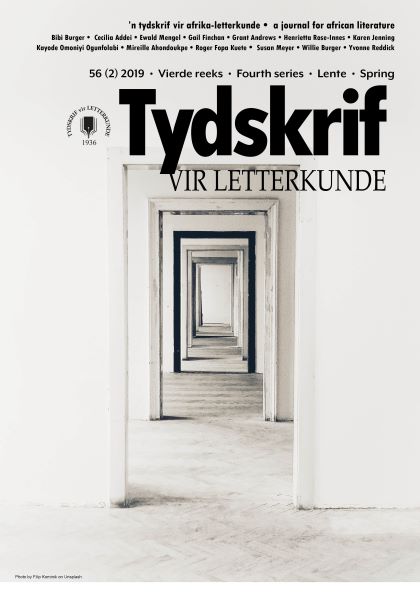The iconic Hector Pieterson photo and the power of adaptations
DOI :
https://doi.org/10.17159/2309-9070/tvl.v.56i2.6134Mots-clés :
Hector Pieterson, repetition compulsion, symbolization compulsions, adaptation, trauma, artRésumé
In South Africa, the iconic Hector Pieterson photo is the starting point for many artists to deal with their own personal trauma and the communal trauma of their nation. The iconicity of this photo has sparked many different adaptations in various fields of art. Considering that we are talking about a traumatized country, Freud’s concept of “repetition compulsion” seems to be one explanation for this phenomenon. However, art is only seldom a mere product of traumatization. Quayson’s concept of “symbolization compulsions” comes closer to explaining the phenomenon of repetition in the arts, because it leaves the artists more freedom of expression and does not suggest that art is the result of illness, while still implying ‘compulsion’ and ‘obsession’ in the act of creation. I want to suggest that ‘repetition’ in the arts in the South African context is not so much a sign of confinement and restriction, but that the many adaptations of the unique historical incident should rather be understood as attempts of ‘working through’ collective trauma, making sense of history, and contributing to the country’s healing.
Téléchargements
Références
BBC News. “Profile: Mandela’s magic touch”. 28 Aug. 2001.
http://news.bbc.co.uk/2/hi/africa/1513244.stm. Accessed 3 Mar. 2019.
Bergman, Mats & Sami Paavola, eds. The Commens Dictionary. Peirce’s Terminology in His Own Words. 2003. http://www.commens.org/dictionary. Accessed 3 Mar. 2019.
Boehmer, Elleke. “Permanent Risk: When Crisis Defines a Nations Writing”. Trauma, Memory, and Narrative in South Africa: Essays. Eds. Ewald Mengel & Michela Borzaga. Rodopi, 2012, pp. 28–46.
Caruth, Cathy. Unclaimed Experience: Trauma, Narrative, and History. Johns Hopkins U P, 1996.
Davids, Nashira & Gabi Mbele. “Emotion high at rework of iconic picture”. The Herald (South Africa). 17 Jun. 2015. https://www.pressreader.com/south-africa/the-herald-south-africa/20150617/281535109621617. Accessed 8 Mar. 2019.
Ferreira, Thinus. “Channel O Youth Day ad stirs up a storm”. Channel 24. 17 Jun. 2015. https://www.channel24.co.za/TV/News/Channel-O-Youth-Day-ad-stirs-up-a-storm-20150617. Accessed 8 Mar. 2019.
Freud, Sigmund. “Beyond the Pleasure Principle.” On Metapsychology. Ed. Angela Richards. Penguin, 1984, pp. 275–338.
Hutcheon, Linda. A Theory of Adaptation. Routledge, 2006.
Mengel, Ewald. On First Looking into Arden’s Goethe: Adaptations and Translations of Classical German Plays for the Modern English Stage. Camden House, 1994.
Mengel, Ewald & Michela Borzaga, eds. Trauma, Memory, and Narrative in the Contemporary South African Novel: Essays. Rodopi, 2012.
Molosankwe, Botho “Hector Pieterson pic ruined my life.” IOL. 12 Jun. 2013. http://www.iol.co.za/news/south-africa/gauteng/hector-pieterson-pic-ruined-my-life-1.1531027#.U0fi1V4ijwI. Accessed 3 Mar. 2019.
Pohlandt-McCormick, Helena. “Story of a Photograph—Sam Nzima”. Gutenberg-e.org. http://www.gutenberg-e.org/pohlandt-mccormick/pmh01a.html. Accessed 3 Mar. 2019.
Quayson, Ato. “Symbolization Compulsions.” Calibrations: Reading for the Social. Ed. Ato Quayson. U of Minnesota P, 2003, pp. 76–98.
Saayman-Hattingh, Heidi. “Understanding Cultural Identity and Visual Communication in the Appropriation of Iconic Photojouralism.” The Sixth International DEFSA Conference Proceedings 2011, pp. 172–82. http://www.defsa.org.za/papers/understanding-cultural. Accessed 22 Jun. 2019.
South African History Online. “Black Concentration Camps during the Anglo-Boer War 2, 1900–1902.” http://www.sahistory.org.za/topic/black-concentration-camps-during-anglo-boer-war-2-1900-1902. Accessed 3 Mar. 2019.
Tutu, Desmond. Archbishop Tutu’s Address to the First Gathering of the Truth and Reconciliation Commission. http://www.justice.gov.za/trc/media/pr/1995/p951216a.htm. Accessed 3 March 2019.
Volkan, Vamik D. “The Next Chapter: Consequences of Societal Trauma.” Memory, Narrative and Forgiveness: Perspectives on the Unfinished Journeys of the Past. Eds. Pumla Gobodo-Madikizela & Chris van der Merwe. Cambridge Scholars, 2009, pp. 1–26.
Wylie, Dan & Joan-Mari Barendse, eds. Dogs in Southern African Literatures. Van Schaik, 2018.
Zapiro. Obituary cartoon: Nkosi Johnson. https://www.zapiro.com/010605so. Accessed 3 Mar. 2019.
Téléchargements
Publiée
Numéro
Rubrique
Licence
(c) Copyright Tydskrif vir Letterkunde 2019

Ce travail est disponible sous licence Creative Commons Attribution - Partage dans les Mêmes Conditions 4.0 International.


 https://orcid.org/0000-0001-6465-6584
https://orcid.org/0000-0001-6465-6584


.png)